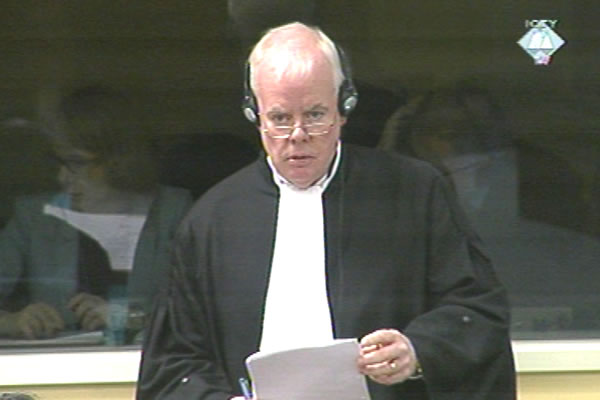Home
PROSECUTION COLLECTS EVIDENCE ON TOMASICA
The prosecution has announced it intends to re-open its case at the trial of Ratko Mladic to present evidence on the mass grave in the Tomasica mine near Prijedor. The defense has asked for a break of at least six months to prepare its case
 Dermot Groome, prosecutor at the Ratko Mladic trial
Dermot Groome, prosecutor at the Ratko Mladic trial Prosecutor Dermot Groome has indicated that he will seek to re-open the prosecution case at the trial of Ratko Mladic to call the evidence pertaining to the recently discovered mass grave in the Tomasica mine near Prijedor.
The prosecutor has estimated he would need two weeks in March 2014 to call this evidence. Groom stressed that the evidence was relevant not only for the effort to establish the death of the victims but also to prove there had been ‘a vast operation to kill and bury’ those people. That is relevant for the allegations in Count 1 in the indictment charging Mladic with genocide.
Given that the prosecution case is set to end in two weeks’ time, the defense has announced that it would need the same amount of time as the prosecution for its case. The defense intends to call approximately the same number of witnesses. The prosecution has taken about 200 hours to present its case so far. Defense counsel Branko Lukic has asked for at least six months to prepare the defense case. However, if the prosecution re-opens its case to present new evidence on Tomasica in March 2014, Lukic will ask twice the time allotted to the prosecution for that purpose. The defense plans to take as much time as the prosecution to call its evidence on Tomasica, and will need as much time again to prepare the evidence.
The defense has also indicated it intends to file a Rule 98 bis motion after the prosecution rests its case. This rule give the defense the opportunity to call for the acquittal of the accused at the half-time of the trial on the counts in the indictment for which, in its view, the prosecution has failed to call sufficient evidence which would lead to a conviction if left unchallenged. The motion will be not be submitted before February 2014.
Before this latest development, the prosecution recalled OTP investigator Barry Hogan for a brief re-examination. In September 2013, Hogan testified about the sniper incidents and the shelling in Sarajevo. In his evidence today, Hogan was showed two maps of Sarajevo, a Sarajevo-Romanija Corps operations map from July 1992 and the BH Army map from March 1995. The witness marked the lines of conflict on both maps. According to the witness, there was not much difference between the positions in 1992 and 1995.
The prosecutor asked Hogan to mark a number of hills: Debelo Brdo, Colina Kapa, Mojmilo, Hum, Hrasno and Hrasno Brdo on the maps. Hogan confirmed that the hills were held by the BH Army and that the Serb army positions overlooked those hills. Hogan said that Mount Zuc ‘changed hands several times’ while Mount Trebevic, Dobrinja 1 and Dobrinja 2 remained under the SRK control throughout the war. The BH Army controlled the rest of Dobrinja.
At the defense counsel’s request, Hogan marked on the map of Sarajevo the locations controlled by the BH Army: Vranjace, Gordonj Brdo, Brijesce Brdo and Balino Brdo. The defense alleges that the BH Army could control Vogosca from those positions.
Linked Reports
- Case : Mladic
- 2013-11-26 VALID INSTRUCTIONS AND UNAUTHORIZED ORDERS
- 2013-11-25 ABOUT PRISONERS ‘INDIRECTLY, WITHIN LIMITS OF LEGALITY’
- 2013-11-22 NUTRITIONIST IN MANJACA PRISON CAMP
- 2013-12-02 ETHNIC DIVISION IN BH
- 2013-12-03 MLADIC WAS ACTIVE AND INFORMED COMMANDER
- 2013-12-05 STRATEGIC GOALS ACHIEVED UNDER MLADIC’S COMMAND
